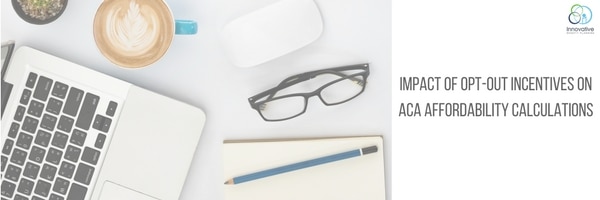Quick Overview of Affordability
Employers may find themselves subject to a penalty if an employee goes to the Marketplace/Exchange and obtains a premium credit, because the employer plan was not affordable or does not provide minimum value.
An employee is not eligible for a premium tax credit for any month in which the employee is offered employer sponsored coverage that is affordable and offers minimum value. Affordability is measured as 9.66% for 2016 or less of household income. For purposes of determining group health affordability, many employers look to the cost of self-only coverage compared to an employee’s W-2 wages.
Offering incentives to employees who waive coverage is not uncommon. Incentives can provide extra cash to employees, especially if the employee has other coverage available. Incentives also help lower plan costs.
Proposed Regulations Impacting Affordability
An opt-out payment may have the effect of increasing an employee’s contribution for health coverage beyond the amount of any salary reduction contributions. The current regulations provide that an employee’s required contribution for coverage includes the amount by which the employee’s salary would be reduced to enroll in coverage, to determine employer-sponsored coverage affordability.
Although these regulations are considered “proposed”, the IRS has indicated that for plan years after January 1, 2017, the unconditional opt-out payment arrangement (discussed below) will increase an employee’s required contribution for affordability purposes. The IR S has provided in the proposed regulations that taxpayers should move forward with the guidance provided in the regulations.
Unconditional Opt-Out Payments
The IRS has proposed regulations that indicate if an employer makes an opt-out payment available to an employee, then the amount of the payment made under the unconditional opt-out arrangement increases the employee’s required contribution. The IRS proposed that it will treat an unconditional opt-out arrangement (an arrangement providing a payment conditioned solely on an employee declining coverage under an employer’s health plan and not on an employee satisfying any other meaningful requirement) in the same manner as a salary reduction for purposes of determining an employee’s required contribution relating to affordability.
IRS provided the following example in their proposed regulations:
An employer offers coverage through an IRC 125 plan costing $200 per month for employee coverage. The employer offers $100 per month to employees who decline coverage. The IRS would consider this offer of $100 as additional compensation and therefore has the economic effect of increasing the employee’s contribution for the coverage, effectively making the cost of coverage $300. The rationale behind this is that the employee electing coverage is giving up $200 in compensation for the cost of coverage as well as the $100 incentive to decline.
Conditional Opt-Out Payments
The proposed regulations create a different rule for conditional opt-out payments. Amounts made available under conditional opt-out arrangements are disregarded in determining the required contribution, if the arrangement satisfies certain conditions. An eligible opt-out arrangement is an arrangement under which the employee’s right to receive the opt-out payment is conditioned on:
- The employee declining to enroll in the employer-sponsored coverage;
- The employee providing reasonable evidence that the employee and employee’s expected tax family have or will have minimum essential coverage (other than coverage in the individual market, whether or not obtained through the Marketplace) during the period of coverage to which the opt-out arrangement applies; and
- The employer having no knowledge or no reason to know that the employee or any other member of the employee’s expected tax family does not have or will not have the required alternative coverage.
Reasonable evidence of alternative coverage includes the employee’s attestation that the employee and members of their fax family have or will have minimum essential coverage, as outlined above. Evidence must be provided at least every plan year to which the eligible opt-out arrangement applies.
Key Take-Aways:
Although the proposed regulations have not been finalized, the IRS has indicated that the proposed regulations are applicable for plan years beginning on or after January 1, 2017, therefore, employers should consider phasing out unconditional opt-out arrangements and replacing them with conditional opt-out payment arrangements as discussed above.
Employers who continue to use opt-out arrangements should consult with their legal counsel to ensure that their arrangements comply with current regulations. If you have questions regarding your arrangement, please contact our office.
Disclaimer: The information provided is general and is provided for educational purposes. It is not intended to be exhaustive, nor does it constitute legal or tax advice. Consultation with a legal or tax advisor is recommended.












